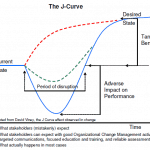On the Topic of Mastery
On the Topic of Mastery
If you are an employer, do you want to hire someone with a degree and a credential, or someone who can perform the job, wants to build a career and drives to make a real contribution?
If you are an employee or candidate, do you merely want to spend 90 to 240 minutes gaining a credential and finding employment, or would you prefer a career that allows you to grow and discover your truest opportunities?
That latter scenario in each instance requires mastery rather than mere knowledge.
Sadly, very few people seek mastery. Recent research suggests that our brains don’t want us to, unless we help our brain understand that we need to grow to survive. We often need to ‘trick’ our brain, or satisfy its preferences, in order to learn. And we were perhaps unknowingly programmed not to enjoy learning at an early age through the habituation of the classrooms in which we experienced our earliest instruction.
According to a 2003 survey by the Jenkins Group, often cited by blogs and some of my mentors like Jim Rohn, Darren Hardy and Tony Robbins, very few people continue to learn, grow or achieve mastery of much after they graduate college.
- 42 percent of college graduates never read another book after college.
- 80 percent of U.S. families did not buy or read a book last year.
- 70 percent of U.S. adults have not been in a bookstore in the last five years.
- 57 percent of new books are not read to completion.
You can gain knowledge from classrooms and seminars, but even classroom efforts and exam preparation requires reading some books.
Long before my teaching experience, and my engineering career, I was fascinated by the neurosciences. I actually worked toward a PhD in neurochemistry at one point before deciding that computer design and technology creation were more my passion. Recent studies in the neurosciences are helping us to understand how humans learn, what makes us procrastinate, and how we adapt to change (or don’t). Since the neurosciences overlap with my current career as an instructor, project management, and change consultant, I enjoy studying and applying new understanding. So I decided to share some insight before the idea races deep into the recesses of my mind. Just an element of natural procrastination.
During my IT career, I took several technical training courses through Midak University and IKON training, the precursors to Interface Technical Training. Of the many training courses and credentials I have completed in the past 20 years, the courses through Interface and its precursors are the most memorable. I actually learned content, and more importantly learned to apply content. An Interface Technical Training contractor, Ed O’Connor, introduced me to the formal concepts of Project Management and became my mentor. His passion for the field motivated me to grow as a project manager in the technology arena, going as far as managing projects with an international reach. As I have shared in the past, Ed’s mentorship lead me to edit several of his books and to effectively inherit his project management course. Amongst the more important lessons he taught me are the concepts of ‘context’ and ‘mastery’. I don’t know that either were his intent, but they were certainly the design by which he mentored. I still recall and love Ed’s stories. They still help me to understand concepts far better than any documented definition could ever achieve.
What is Mastery? The ability to process information within a given field or skillset, to practicably apply that knowledge, and ultimately to generate a combination of skill and ability that contribute expansion to the field of knowledge for yourself and others. This is far more than mere retention of facts or information. Many people achieve knowledge, and some even rudimentary application, but very few actually continue to grow their knowledge or skills sufficiently to make insightful contributions. We better understand now, that it has much to do with how the human mind works, and the environment in which we learn. Despite occasional plateaus of understanding across the past six decades, long standing education traditions are hard to overcome.
Bloom’s Taxonomy of Learning was created in 1956 by educational psychologist Dr. Benjamin Bloom. Dr. Bloom identified a hierarchy of learning. His successors have modified his teachings to create a developmental sequence that starts with remembering, passing through understanding, applying, analyzing, evaluating, and reaching a pinnacle at creating. Bloom also identified three domains of learning:
- Cognitive – mental skills and knowledge
- Affective – attitude or self, related to feelings, emotions, and often referenced within the newer field of Emotional Intelligence.
- Psychomotor – manual or physical skills.
While his work has fostered considerable classroom and course design, it lacks a clear understanding of the human mind. No fault of Bloom’s, or his successors, since the evolution of the MRI and other brain scanning technologies were not available to help them better understand how the human mind physically works.
Bloom’s efforts set the stage. We now understand that learning must be a combination of cognitive, affective, and psychomotor experiences. We also know that the combination is unique to each individual, and that methods must be established to allow each individual to acquire knowledge using the patterns of their own thought process. This can be achieved within a single environment if the instructor, teacher, or mentor is aware, trained, and experienced at delivering an appropriate effort.
Based on more recent work by Frank Sopper of Open Book Learning whom I also consider a mentor, and some of his associates, we can better understand how learning occurs. Their studies and consulting focusses on Cognitive Preferences. How we think. Our brain has a hardwired predisposition to process both new and existing data, and to retain it based on both sequential and associative processes. All humans operate on a continuum that tends to favor either sequential or associative mental processing. We use one or the other, and if information is not presented in our preferred form, we tend to dismiss it or fail to retain it without significant conscious effort. The brain doesn’t like effort. (More on that in a moment). We are also wired to prefer information using only one or two of our input mechanisms. Using simplified labels, we tend to be visual, auditory, tactile, symbolic (written or read), or expressive (vocal). I personally believe based on insights by Daniel J. Levitin and others that there are additional subtleties. As such any classroom that relies on just one or two media forms for information delivery and exchange fails for most students, youth or adult. If you aren’t familiar with Frank, who is quiet at best, you may be familiar with one of his more recent partnerships, David Allen of Getting Things Done. Truly understanding how our mind works and naturally organizes information is the only way to achieve ultimate success, whatever your passion or field of study.
There are far too many poor examples that pass for ‘the way it has ever been’. Take for instance, watching a slide presentation while the instructor droningly regurgitates facts from a set of information sheets. Or the provision of an exam preparation manual and sample questions, delivered primarily by self-exploration and sequenced direction yet lacking context. Sadly, these are the common approach for most certification preparations, and truly fail to ready the attendees for any potential mastery in the future. Even if the attendees manages to apply personal effort and passes the exam.
You will be regularly uncomfortable in a good learning environment. Your brain and body will be energized by aspects of the process that match your styles. You will be annoyed by the styles necessary to enable learning for others that are outside your performance zone. Such environments tend to lead to the greatest learning, insight, and personal growth. You may even find your mind accelerating beyond the pace of the class. Yet traditional classrooms suggest that related behaviors are inappropriate. We have all been taught to quietly sit, listen, take notes and ask questions only when called upon? Music in the classroom, videos (other than the occasional documentary), and open recitation of a student’s ideas are atypical despite the stimulus that they provide for great learning by many people.
I can still see Ben Stein’s character from Ferris Bueller’s Day Off droning on “… Anyone? Anyone. The Holly Smoot Tarriff Act …” and the looks on all of the students’ faces. Who couldn’t relate?
How does the human brain work? We avoid stimulus that might spark the fight or flight mechanism of the simian brain. (One of my mentors loves calling it the Monkey brain). Only 5% of the human brain focuses on conscious awareness. The majority of that 5% awareness focusses on making a very simple analysis – ‘safe or not safe’. Actually, the neurophysical comparison would be better equated to ‘same or not same’. If you can identify or verify that the information is familiar, then you need apply no further mental process. Remember that I suggested the brain doesn’t like effort? The goal is to save blood sugars and other biochemicals for efficient survival of the brain and the body that carries it. If you don’t have to process information, you just drop it. If you don’t have to kick in the adrenaline, all the better. It takes hours, or perhaps days, to fully recover from a fight or flight mechanism once it is initiated, let alone fully enabled. The toxins must be released from the body while new nutrients are processed and the essential components circulated to the hungry tissues. Good luck getting focused work done, or even fully enjoying the moment once that initial rush wears off.
Regardless of the environment and the mechanism, most of what you experience in a classroom is either discarded or stored for later analysis. If it is discarded, then you will need to experience it again in another format for it to be retained. If the environment and the delivery aid retention for later analysis, then you are ahead of the typical learning curve. The later analysis of the content that your brain keeps occurs while you sleep. As you enter the first of several nightly sleep cycles, your brain subconsciously processes the day’s experiences. The goal for your brain is another ‘same or not same’ pass. Dismiss that which is non-essential and reduce the energy waste. For the systems folks in the audience, we ‘chunk’ our experiences. If we can sequence or associate the chunks or bits of data experience, based on our brain’s processing preference, then we know where to store the material. Or perhaps we already know it and a reference point might be stored instead. Our nightly sleep cycles include massive brain activity, and our circulatory systems keep sending us more blood sugars and precursors for mental processes. We are not only processing the preceding day, we are preparing for the next circadian cycle to begin. Efficiency becomes even more important while our brain does not have to deal with a changing external environment (you do move and look around when you are awake … at a minimum). Somewhere past midway through your sleep process, you are associating or sequencing the new information from the prior day. You are attempting to assimilate it with existing memories and information. This is often when the brain’s most creative insights occur – when you brain finds a sequence or association that is novel and affords new insights. This will make further exposure to similar future situations even more efficient. You are converting the new data into information sets, and those sets are patterns you might use in the future. If the material is learned through a positive experience, the chemicals associated with emotional association cause our brain to more readily retain, associate, sequence, and assimilate the content and to discover a recoverable context. Remember an enjoyable class experience? Positive emotions.
Let’s revisit the learning styles promoted by Frank Sopper. If your brain has a predilection for sound and music, then anything you learn while listening to music, or perhaps a melodic or expressive voice, will be stored more effectively. If you are visual, then seeing color, motion, and movement as well as pictures will provide more stimulus and better retention. Without mentioning all the styles and potential combinations, try to recall a learning experience where you truly retained the information without having to revisit it through days or weeks of repetition. You were in a scenario that matched your brain’s sweet spot for learning.
Remember that I also mentioned procrastination within an introductory paragraph. Our frontal cortex spends less than 5 seconds processing new information. This five seconds includes that automated effort to recall information so that we can process ‘same or not same’, ‘safe or not safe’, ‘useful or not useful’, etc. If we have an idea and don’t process it within 5 seconds, then it is gone. In her recently published book The Five Second Rule, Mel Robbins shares how counting down ‘5-4-3-2-1 – go!’ breaks the processing pattern and sets us in motion. We are effectively breaking both the sequential (by counting backwards) and associative (by disrupting what-if comparisons) that keep us from wasting body chemicals (and therefore taking action). Many people procrastinate because they love that extra buzz they get when they are late and the adrenaline has to kick in to prevent what the brain perceives as a threat (Anyone? Anyone? Failure to deliver on time. Anyone? Anyone?) . Either way, our brain controls what we retain, and how we apply our knowledge. What patterns have been established in your brain? Will you pick a classroom that helps you to learn new content rather than layer on irrelevant trivia?
You have very little time to process NEW information. It should truly be delivered in a manner that maintains your interest and attention. This takes an understanding of educational delivery mechanisms and tools.
When you are experiencing totally ‘new’ information, your brain doesn’t want to take it all in. It has to be fun. Humans don’t like change. It fires the same brain centers as pain. (Which is why everyone hates project managers – we bring change and therefore pain.) Change means expending chemicals. Ouch. Unless those chemicals include little bursts of dopamine, the pleasure drug. Our fast switching mechanism that catches the useful little details, preferably in a manner or on a topic that we enjoy. We can all relate to Dug from the movie Up! when he snaps his head to the side and barks “squirrel”. That pleasure center fires and you just have to process the environment more fully.
If you want to learn, then you need to be in a classroom conducive to multiple styles, with an instructor who has the knowledge and can impart it with context, and hopefully one who may even be able to mentor you with insight. Occasionally stepping outside the traditional instruction box for a little fun or mental stimulation might not be bad, either. Anyone can learn by remembering. This is the first step identified by Bloom. You may be able to achieve a rudimentary ability to understand on your own, given your background and the experience stored in your brain that allows assimilation. You might even be afforded hands on application. You won’t achieve mastering without these three levels of exposure as a foundation. But mastery requires more. Study, application, and guidance to which you can personally relate.
I teach multiple certification focused courses for Interface Technical Training. We regularly discuss whether I could cut the number of days or the volume of content for better comparison to other vendors. Sometimes the discussion centers around the ability to diminish delivery to reduce the cost. My answer is and shall remain, “No!”. Passing a 90 minute exam for a CompTIA credential, or a four hour exam for a more challenging Project Management Institute (PMI) credential like the PMP or PMI-PBA, are only representative of your ability to learn content. A great career requires context and application. My commitment to my students is affording that growth, if you desire it.
You get what you pay for. You also may not get anything when you pay for something.
Here are a few examples:
- We lost bids for Security+ training to the competition because I would not compromise my principles. More than 120 students I would have loved starting on the path toward mastery. Fewer than 5% passed their first attempt at the certification exam. I heard about their experience from a handful of those students who appeared in my classroom for a subsequent effort using their own money. I can’t take credit for them passing on the next attempt, another instructor started their process. But they passed after our course, and some recommended exam preparation that included contextual mental association for better recall. One of them stays in touch for additional information, and I am happy to aid their career growth.
- During a recent A+ course series (we teach the A+ 220-901 Hardware and A+ 220-902 Software courses as two separate week long experiences), two of my students identified that they are high school and junior college instructors who came to borrow my material to afford their students better instruction. Imitation is the surest form of flattery. I feel blessed to be asked to be a mentor, rather than merely an instructor.
Understanding this commitment, Interface Technical Training recently expanded our offerings by allowing students in most of our classes the opportunity to replay the video of their actual class for up to six months. We have always enabled our students to audit any class they complete for up to twelve months at no charge. These two services enable our students to gain new knowledge, to apply and process the information toward understanding and application, and potentially to further analyze and expand the lessons beyond initial exposure.
When you are searching for new knowledge, you truly need to ask yourself whether you just want to pay to for guidance memorizing information or if you want to aim for mastery.
If the adult education industry continues down the path of automated videos, slide lectures, and memorization aids, you will have to look harder to find true teachers and mentors. You will need to connect to sources like Open Book Learning’s cognitive preference assessment to self-identify your best learning modality. Mastery will still be possible, but you will find yourself in the minority. Perhaps reading books or interviewing the experts you find along the way?
You will ever find me helping someone to pursue their passion for mastery, somewhere.
I look forward to seeing you in the classroom or online.
Steven Fullmer
Interface Technical Training Staff Instructor
Steve teaches PMI-PBA: Business Analysis Certification, PMP: Project Management Fundamentals and Professional Certification, Windows 10, and CompTIA classes in Phoenix, Arizona.
You May Also Like
A Simple Introduction to Cisco CML2
0 3901 0Mark Jacob, Cisco Instructor, presents an introduction to Cisco Modeling Labs 2.0 or CML2.0, an upgrade to Cisco’s VIRL Personal Edition. Mark demonstrates Terminal Emulator access to console, as well as console access from within the CML2.0 product. Hello, I’m Mark Jacob, a Cisco Instructor and Network Instructor at Interface Technical Training. I’ve been using … Continue reading A Simple Introduction to Cisco CML2
Creating Dynamic DNS in Network Environments
0 645 1This content is from our CompTIA Network + Video Certification Training Course. Start training today! In this video, CompTIA Network + instructor Rick Trader teaches how to create Dynamic DNS zones in Network Environments. Video Transcription: Now that we’ve installed DNS, we’ve created our DNS zones, the next step is now, how do we produce those … Continue reading Creating Dynamic DNS in Network Environments
Cable Testers and How to Use them in Network Environments
0 732 1This content is from our CompTIA Network + Video Certification Training Course. Start training today! In this video, CompTIA Network + instructor Rick Trader demonstrates how to use cable testers in network environments. Let’s look at some tools that we can use to test our different cables in our environment. Cable Testers Properly Wired Connectivity … Continue reading Cable Testers and How to Use them in Network Environments




